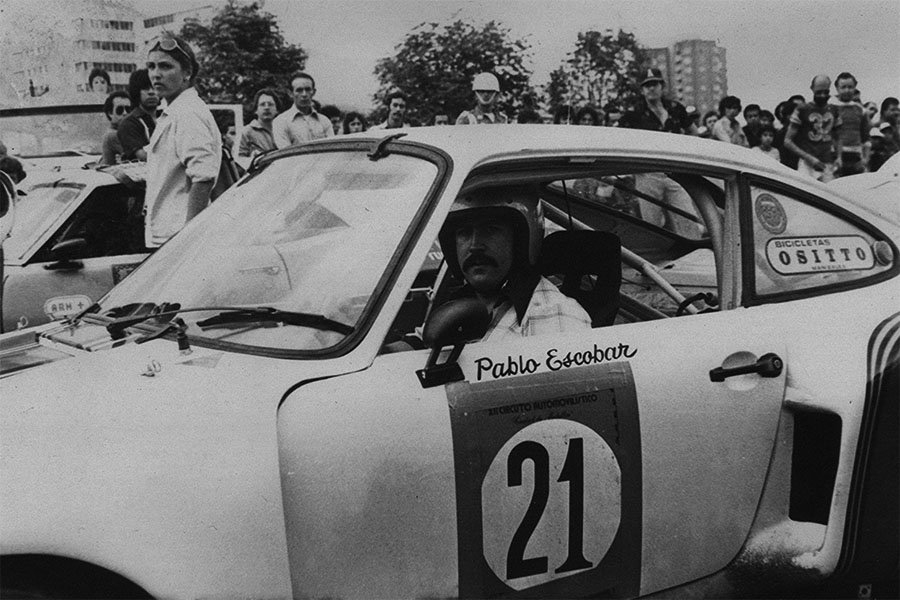VIN: the Roger Penske / Jim Tunstall / Pablo Escobar Porsche 911 3.0 Carrera RSR IROC chassis 9114600100
/HISTORY OF CHASSIS 9114600100
Chassis 9114600100 was one of the 15 cars specially produced by Porsche to contest the inaugural International Race of Champions (IROC).
Organised by Roger Penske Enterprises, the IROC series brought together twelve of the world’s top drivers to contest three 30 lap heats at Riverside in October 1973. Afterwards, the six drivers that had accumulated the most points would go on to compete in a 25 lap finale at Daytona in February 1974.
All 15 of the IROC 911s were finished in different colours. Chassis ‘0100’ was painted Sahara Beige. For the opening heat at Riverside it was allocated to 1972 Formula 1 World Champion, Emerson Fittipaldi.
Despite having been the only driver in attendance never to race at Riverside, Fittipaldi qualified on pole. However, because he was delayed by the traffic in Los Angeles, Fittipaldi arrived late to the pre-race driver’s meeting and was sent to the back of the grid.
By lap six of the race, Fittipaldi had nearly caught sixth placed Denny Hulme. Unfortunately, the Brazilian span on lap seven, damaged a fuel line and retired.
Chassis ‘0100’ was replaced by one of the spare cars for Heats 2 and 3 and played no further part in the weekend’s racing.
After the Riverside heats, eight of the IROC 911s were sent back to Porsche for a series of upgrades. ‘0100’ was one of the seven examples that remained in the US.
A few days after the Riverside heats, it had been sold to North Lake Porsche Audi in Tucker, Georgia.
In June 1974, North Lake Porsche-Audi sold the car to amateur driver, John Tunstall, who ran T&C Racing of Sarasota, Florida.
Tunstall campaigned the 911 until early 1978, taking in three runnings of the Sebring 12 Hours. His other four outings included two appearances at the Road Atlanta 100 miles where he scored a best finish of eleventh in 1977.
Tunstall’s final race with ‘0100’ was at the 1978 Daytona 24 Hours. He retired with a broken flywheel. By this time, the Porsche had been uprated with a 935-style front bumper and back end. The colour scheme was now white with blue and red stripes.
In early 1979, Tunstall sold chassis ‘0100’ to Pablo Escobar of Medellin, Colombia.
Escobar was an infamous drug trafficker who led the Medellin Cartel which smuggled tens of millions of dollars worth of cocaine into North America every week. By the time he purchased ‘0100’, Escobar had amassed a billion dollar fortune and was one of the world’s richest men.
During the 1980s, battles between rival cartels and the authorities led to an explosion in violence. Murders of competitors, police officers, judges and politicians were commonplace as the cartels began to employ their own paramilitary forces.
After Escobar was expelled as a member of the Colombian Congress in 1983 (he had been elected in 1982), the violence worsened. In his fight against extradition laws to the US, Escobar is alleged to have backed the 1985 storming of the Colombian Supreme Court by M-19 guerrillas (33 dead), the 1989 bombing of Avianca flight 203 (107 dead) and the 1989 bombing of the Administrative Department of Security (63 dead).
At the height of Escobar’s powers in the late 1980s, the Medellin Cartel controlled 80% of the world’s cocaine production and was generating profits of more than $70m per day.
Escobar owned several high end cars to include a Mercedes-Benz 600 and 190 SL, a Rolls Royce Phantom 1, a Porsche 356 A Coupe and a 911 Targa. He also liked to race and contested the 1979 Copa Renault in which he took second place in the Amateur standings.
Prior to its dispatch to Colombia, chassis ‘0100’ was further uprated with flat nose 935-style front fenders and side skirts. Escobar and his cousin (Gustavo Gaviria) subsequently raced the car in a number of local hillclimbs and street contests.
Escobar died after following a shoot out with law enforcement in Medellin during December 1993.
By this stage, chassis ‘0100’ had been sold to fellow Colombian, Sergio Garcia, who raced the car domestically for several seasons.
In 1993, the 911 was sold to Porsche expert, Jim Torres in California.
Years later, the car was restored back to its original IROC configuration.
Notable History
Ordered by Roger Penske Enterprises, Detroit, Michigan
Sahara Beige
27/10/1973 IRC Riverside 1 (E. Fittipaldi) DNF (#1)
27/10/1973 IRC Riverside 2 (unused)
28/10/1973 IRC Riverside 3 (unused)
Sold to John Tunstall (T&C Racing), Sarasota, Florida
21/03/1975 IMS Sebring 12 Hours (J. Tunstall / J. Jenkins) DNF (#54)
20/03/1976 IMS Sebring 12 Hours (J. Tunstall / C. Wade) 23rd oa, 16th GTO class (#52)
11/04/1976 IMS Road Atlanta 100 miles (J. Tunstall) 12th oa, 12th GTO class (#52)
19/03/1977 IMS Sebring 12 Hours (J. Tunstall / C. Wade) DNF (#57)
17/04/1977 IMS Road Atlanta 100 miles (J. Tunstall) 11th oa, 11th GTO class (#57)
04/07/1977 IMS Daytona 250 mile (J. Tunstall) DNF (#54)
05/02/1978 IMS Daytona 24 Hours (J. Tunstall / S. Behr / L. Timolat) DNF (#54)
Sold to Pablo Escobar, Medellin, Colombia
Converted to 935-style bodywork
Later sold to Sergio Garcia, Colombia
1993 sold to Jim Torres, Burbank, California
Later restored to original configuration
Text copyright: Supercar Nostalgia
Photo copyright: unattributed































